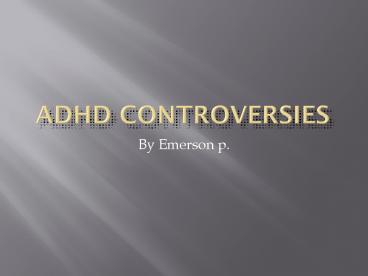ADHD Controversies PowerPoint PPT Presentation
1 / 7
Title: ADHD Controversies
1
ADHD Controversies
- By Emerson p.
2
Controversy Diagnosis
- The first controversy involves the accuracy and
reliability of how ADHD is diagnosed. In the U.S,
about 3 to 5 million school-age children are
diagnosed with ADHD,with 4t o 5 times as many
boys having ADHD as girls. Parents or teachers
may label a child a child as having ADHD if the
child is overwhelmed by the demands of school and
acts outgoing, rambunctious , or difficult to
discipline, since of diagnostic difficulties,
pediatricians and family doctors were recently
given the following guidelines for diagnosing
ADHD Children should be 6-12 years old, show six
or more symptoms of inattention and
hyperactivity, have symptoms for at least six
months, and symptoms should occur in both home
and school.
3
Controversy treatment
- Nondrug behavioral treatment- there is a nondrug
behavioral treatment program that involve
changing or modifying undesirable behaviors
using learning principles. Such a behavioral
treatment program, which requires considerable
efforts by the parents, has been effective in
reducing ADHD symptoms. - Combined drug and behavioral treatment- the group
of experts recommended a combination of Ritalin
(methylphenidate) and behavioral treatment when
children have more severe ADHD, when children
also have significant aggression or have serious
problem n school, or when there is need for a
rapid response to severe ADHD symptoms. The use
of Ritalin has risen 600 since 1993.
4
Controversy Long-term effects
- the third controversy involves the long-term
effects of ADHD. Many children diagnosed and
treated for ADHD have now reached their early
twenties. Researchers found that even when ADHD
children are treated with Ritalin, between 30 and
70 continue to have problems as adolescents and
adults. They are less likely to graduaiate from
high school or attend collage (only 1 finish
college) and are at risk for showing antisocial
behaviors, such as fighting , trouble with the
law, or drug abuse.because ADHD is contiuing
problem, researchers encourage parents and
teachers to include behavioral programs such as
setting goals, establishing rules, and rewarding
performance to help those with ADHD deal with
adolescence and adulthood.
5
Code of ethics
- Experiments are not approved unless any
potentially damaging effects can be eliminated
or counteracted. Counteracting potentially
harmful effects is usually done by thoroughly
describing the experiment, a process called
DEBRIEFING. Debriefing includes explaining the
purpose and method of the experiment ,asking the
participants their feelings about being
participants in the experiment, and helping the
participants deal with possible doubts or guilt
that arise from their behaviors in the experiment
6
Role of deception
- One way researchers control for participants
expectations is to use bogus procedures or
instructions that prevent participants from
learning the experiments true purpose. However,
before researchers can use bogus or deceptive
methology,they must satisfy the American
psychology associations code ethics.reseachers
must justify the deceptive techniques by the
scientific, educational, or applied value of the
study and by giving participants a sufficient
explanation of the study as soon as possible.
7
Ethics of animals reseachers
- An estimated 18 to 22 million animals are used
each year in biomedical researcher, which
includes the fields of psychology, biology,
medical, and pharmaceutical. Although these
numbers seem larger, they are small in comparison
to the 5 billion chickens eaten annually by
citizens in the united states. However, it is the
use of animals in researcher that has generated
the most concern and debate. In the fields of
psychology, about 85 of the nonhuman animals
used by researchers are rats and mice, while 10
are cats,dogs,monkeys, and birds. Well examine
the justification for using animals in research
and how their rights are protected.

